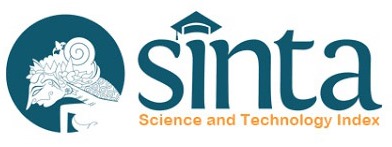Peningkatan Nilai Tambah Kulit Ikan Tuna sebagai Bahan Baku Pupuk Organik Cair
Abstract
Limbah kulit ikan tuna sirip kuning merupakan produk sampingan dari PT. YPT, Banda Aceh yang belum dimanfaatkan. Kulit ikan mengandung unsur N, P, dan K yang yang dapat dimanfaatkan untuk pupuk. Penggunaan Pupuk Organik Cair (POC) berbasis hasil samping industri hasil perikanan masih belum berkembang dengan baik. Penelitian ini bertujuan untuk memanfaatkan limbah kulit ikan tuna sirip kuning menjadi POC menggunakan metode fermentasi tradisional, mengkaji komposisi kimia (mineral) yang terkandung, dan menentukan dosis terbaik penambahan POC yang dihasilkan pada tanaman kangkung. POC dibuat dengan 2 perlakuan, yaitu penambahan molase sebanyak 2% (POC2%) dan 4% (POC4%). Uji organoleptik meliputi parameter aroma dan warna kemudian dianalisis menggunakan Uji Kruskal-Wallis. Analisis komposisi mineral POC menggunakan X-ray flouresence (XRF) dengan pupuk cair kimia sebagai pembanding. Pengujian aplikasi pupuk cair (POC dan pupuk cair komersil) pada tanaman kangkung dilakukan dengan parameter pengamatan tinggi tanaman dan jumlah daun. Berdasarkan uji organoleptik diketahui bahwa perlakuan POC4% lebih cepat mengalami proses pematangan dibandingkan dengan POC2%. Uji Kruskal-wallis menunjukkan bahwa konsentrasi molase berpengaruh nyata terhadap parameter warna, namun tidak berpengaruh terhadap parameter aroma. Hasil uji XRF menunjukkan bahwa POC menghasilkan berbagai unsur hara mikro (Si, Cl, Fe, Mn, B, dan Zn) serta unsur makro (P, K, Ca, dan S) yang relatif lengkap memenuhi kebutuhan tanaman. Berdasarkan uji yang dilakukan, POC4% memiliki karakteristik yang lebih baik dibandingkan POC2%. Dosis penggunaan optimal POC4% adalah 4 ml/L, namun aplikasi dengan konsentrasi 2 ml/L telah menghasilkan pertumbuhan kangkung yang setara dengan penggunaan pupuk cair komersil sebanyak 12 ml/L (dosis yang disesuaikan anjuran penggunaan pada kemasan).
Abstract
Yellow-fin tuna skin waste is a by-product of PT. YPT, Banda Aceh that has not been utilized. The fish skin waste contains N, P, and K elements which are applicable for fertilizer. Currently, the use of Liquid Organic Fertilizer (LOF) is still not well developed. This study aims to determine the utilization of yellow-fin tuna skin waste into LOF using traditional fermentation methods, examining the chemical composition (minerals) contained and detecting the best dose of liquid organic fertilizer for the growth of water spinach. LOF was made with 2 treatments: molasses addition of 2% (POC2%) and 4% (POC4%). The organoleptic test included odour and color parameters, analyzed using the Kruskal-Wallis Test. Mineral composition test was performed using X-ray fluorescence (XRF), with chemical liquid fertilizer as a comparison. Application test of liquid fertilizer (LOF and commercial liquid fertilizers) on water spinach with observation parameters of the plant height and number of leaves. Based on the organoleptic test, it is known that LOF4% treatment undergoes a maturation process faster than that of LOF2%. The Kruskal-Wallis test showed that molasses concentration had a marked effect on the color parameter but had no effect on the odour parameter. The results of the XRF test showed that the LOF from this study contained relatively complete range of micronutrients (Si, Cl, Fe, Mn, B, and Zn) and macronutrients (P, K, Ca, and S) which are needed by plants. Based on the test conducted, LOF4% has better characteristics than LOF2%. The optimal application dose of LOF4% is 4 ml/L, but the use of 2 ml/L has resulted in water spinach growth equivalent to the application of commercial liquid fertilizer of 12 ml/L (the dose recommended for use on the package).
Keywords
Full Text:
PDF (Bahasa Indonesia)References
Ahuja, Ishita., Dauksas, E., Remme, J.F., Richardsen, R., Loes, A.K. (2020). Fish and fish waste-based fertilizers in organic farming – with status in Norway: A Review. Waste Management, 115, 95–112. https://doi.org/10.1016/j.wasman.2020.07.025.
Argo, W.R & J.A. Biernbaum. (1997). The effect of root media on root-zone pH, calcium and magnesium management in containers with impaties. Journal of the American Society for Horticultural Science, 122(2), 275-284.
Alkhafaji, B. Y., & Elkheralla, R. J. (2019). Effect of adding fish scales in agricultural soils and some characteristics of vigna radiata L. Plant Archives, 19(1), 1041–1043.
Arwansyah, Syam, A., & Arie, J. S. (2019). Penggunaan algoritma FP-Growth untuk mengetahui nutrisi yang tepat pada tanaman padi. Prosiding Seminar Ilmiah Sistem Informasi Dan Teknologi Informasi, VIII(2), 1–11.
Badan Standarisasi Nasional (BSN). (2004). Standar Nasional Indonesia (SNI) No. 19-7030-2004 Spesifikasi kompos dari sampah organik domestik. Jakarta.
Balkhande, J. V. (2020). Devising of organic fertilizer from fish and crab wastes: Waste to best technology. International Journal of Fisheries and Aquatic Studies, 8(2), 1–5.
Buang, A., Yusoff, N., Mat, N., & Khandaker, M. M. (2018). Effects of fish waste extract on the growth, yield and quality of Cucumis sativus L. J. Agrobiotech, 9(1S), 250–259.
Budianto, A., Sahiri, N. & Ikhwan, S.M. 2015. Pengaruh pemberian berbagai dosis pupuk kandang ayam terhadap pertumbuhan dan hasil tanaman bawang merah (Allium ascalonicum L.) varietas Lembah Palu. e-J Agrotekbis, 3(4).
Fahruddin, F., & Sulfahri, S. (2019). Pengaruh molase dan bioaktivator EM4 terhadap kadar gula pada fermentasi pupuk organik cair. Bioma : Jurnal Biologi Makassar, 4(2), 138. https://doi.org/10.20956/bioma.v4i2.6905
Firdausiah, S., Madya, N., Seniwati, & Rapak, M. T. (2021). Chemical properties of fish gelatin from skin and bone of yellowfin tuna (Thunnus albacares). Indonesia Chimica Acta, 14(2), 38–42.
Glogoza, P. (2007). Effect of foliar applied compost tea and fish emulsion on organically grown soybean. U of MN extension service. Januari
Hapsari, N., & Welasih, T. (2011). Pemanfaatan limbah ikan menjadi pupuk organik. Jurusan Teknik Kimia Fakultas Teknologi Industri UPN Veteran. Jawa Timur.
Jafari, H., Lista, A., Siekapen, M. M., & Gha, P. (2020). Fish collagen: extraction, characterization, and applications for biomaterials engineering. Polymer, 12(2230), 1–36.
Kementerian Pertanian. (2011). Pupuk organik, pupuk hayati, dan tanah Peraturan Menteri Pertanian No.70/Permentan/SR.140/10/2011. Jakarta.
Kumar, K. K., Singh, S., Chakraborthy, S., Das, J., Bajaj, M., Hemanth, V., … Banerjee, P. (2019). Recycling fish skin for utilization in food industry as an effective emulsifier and foam stabilizing agent. Turk J Biochem, 44(3), 332–343. https://doi.org/10.1515/tjb-2018-0084
Montero, M., & Acosta, Ó. G. (2020). Tuna skin gelatin production: optimization of extraction steps and process scale-up. CyTA - Journal of Food, 18(1), 580–590. https://doi.org/10.1080/19476337.2020.1801849
Moranda, D. P., Handayani, L., & Nazlia, S. (2018). Pemanfaatan limbah kulit ikan tuna sirip kuning (Thunnus albacares) sebagai gelatin: Hidrolisis menggunakan pelarut HCl dengan konsentrasi berbeda. Acta Aquatica, 5(2), 81–87.
Muscolo, A., Mauriello, F., Marra, F., Calabrò, P. S., Russo, M., Ciriminna, R., & Pagliaro, M. (2022). AnchoisFert: a new organic fertilizer from fish processing waste for sustainable agriculture. Global Challenges, 6(5), 2100141. https://doi.org/10.1002/gch2.202100141
Ningrum, A., Hapsari, M. , Perdani, A. , Sutrisno, E., Pravitri, K. , Ramadhani, N. , & Munawaroh, H. S. (2020). Characteristic of yellow tuna skin (Thunnus albacares) gelatin enriched with spices/herbs. Food Research, 4(6)(December), 2082–2088.
Nurilmala, M., Fauzi, S., Mayasari, D., & Batubar, I. (2019). Collagen extraction from yellowfin tuna (Thunnus albacares) skin and its antioxidant activity. Jurnal Teknologi, 81(2), 141–149. https://doi.org/DOI: https://doi.org/10.11113/jt.v81.11614
Nurilmala, M., Jacoeb, A. M., & Dzaky, R. A. (2017). Karakteristik gelatin kulit ikan tuna sirip kuning. Jurnal Pengolahan Hasil Perikanan Indonesia, 20(2), 339–350.
Nuringtyas, D. P., & Adi, A. C. (2017). Mutu organoleptik, kandungan protein dan betakaroten mie subtitusi ikan rucah dan ubi jalar kuning. Media Gizi Indonesia, 12(2), 164–172. https://doi.org/10.12962/j2580-0914.v4i2.9304
Nurjannah, N., Baharuddin, T. I., & Nurhayati, T. (2021). Ekstraksi kolagen kulit ikan tuna sirip kuning (Thunnus albacares) menggunakan enzim pepsin and papain. Jurnal Pengolahan Hasil Perikanan Indonesia, 24(2), 174–187.
Nurwulandari, A., Rochima, E., Rostini, I., & Praseptiangga, D. (2020). Skin and bone fish waste utilization for gelatine preparation by acid treatments : a review. Global Scientific Journals, 8(7), 1873–1881.
Resende, L. V., & Nascentes, C. C. (2016). A simple method for the multi-elemental analysis of organic fertilizer by slurry sampling and total reflection X-ray fluorescence. Talanta, 147, 485–492. https://doi.org/10.1016/j.talanta.2015.10.007
Sousa, S. C., Vázquez, J. A., Pérez-Martín, R. I., Carvalho, A. P., & Gomes, A. M. (2017). Valorization of by-products from commercial fish species: Extraction and chemical properties of skin gelatins. Molecules, 22(9). https://doi.org/10.3390/molecules22091545
Sugiharti, I. E. P., Raksun, A., & Mertha, I. G. (2022). The effect of liquid organic fertilizer from tofu industrial waste and EM4 on the growth of mustard greens (Brasicajuncea L.). Jurnal Pijar Mipa, 17(4), 554–559. https://doi.org/10.29303/jpm.v17i4.3412
Sundari, I., Maruf, W. F., & Dewi, E. N. (2014). Pengaruh penggunaan bioaktivator em4 dan penambahan tepung ikan terhadap spesifikasi pupuk organik cair rumput laut Gracilaria sp. Jurnal Pengolahan Dan Bioteknologi Hasil Perikanan, 3(3), 88–94.
Suryono, C., Ningrum, L., & Dewi, T. R. (2018). Uji kesukaan dan organoleptik terhadap 5 kemasan dan produk kepulauan seribu secara deskriptif. Jurnal Pariwisata, 5(2), 95–106. https://doi.org/10.31311/par.v5i2.3526
Tiwow, V. M. A., Adrianton, A., Abram, P. H., & NurHopiyanti, N. (2019). Production of liquid and solid organic fertilizer from tilapia fish (Oreochromismossambicus) waste using “Bakasang” traditional fermentation technology. International Journal of Engineering and Advanced Technology (IJEAT), 8(3), 885–888.
Toppe, J., Olsen, R.L., Peñarubia, O.R. (2018). Production and utilization of fish silage. A manual on how to turn fish waste into profit and a valuable feed ingredient or fertilizer. FAO, Rome, p. 28
Yusuf, V. B. (2019). Pengaruh konsentrasi pupuk organik cair (POC) dari limbah ikan lele dumbo terhadap pertumbuhan dan hasil panen tanaman bayam hijau dan sawi hijau. In Sustainability
(Switzerland),11(1). UIN Maulana Malik Ibrahim. Malang.
Zaitun. (1999). Efektivitas limbah industri tapioka sebagai pupuk cair. Tesis. Program Pascasarjana Institut Pertanian Bogor. Bogor
Zaitun, Saeni, M. S., Kooswardhono, M., & Djoefri, H. M. H. B. (2010). Pengaruh pemberian pupuk organik cair hasil proses pencernaan anaerobik limbah industri nata de coco dan kotoran sapi terhadap sifat kimia tanah pada media tanam selada. Agrista, 14(3), 74–81.
DOI: https://doi.org/10.15578/jpbkp.v17i2.861
Refbacks
- There are currently no refbacks.
JPBKP adalah Jurnal Ilmiah yang terindeks :
ISSN : 1907-9133(print), ISSN : 2406-9264(online)
This work is licensed under a Creative Commons Attribution-NonCommercial-ShareAlike 4.0 International License.









